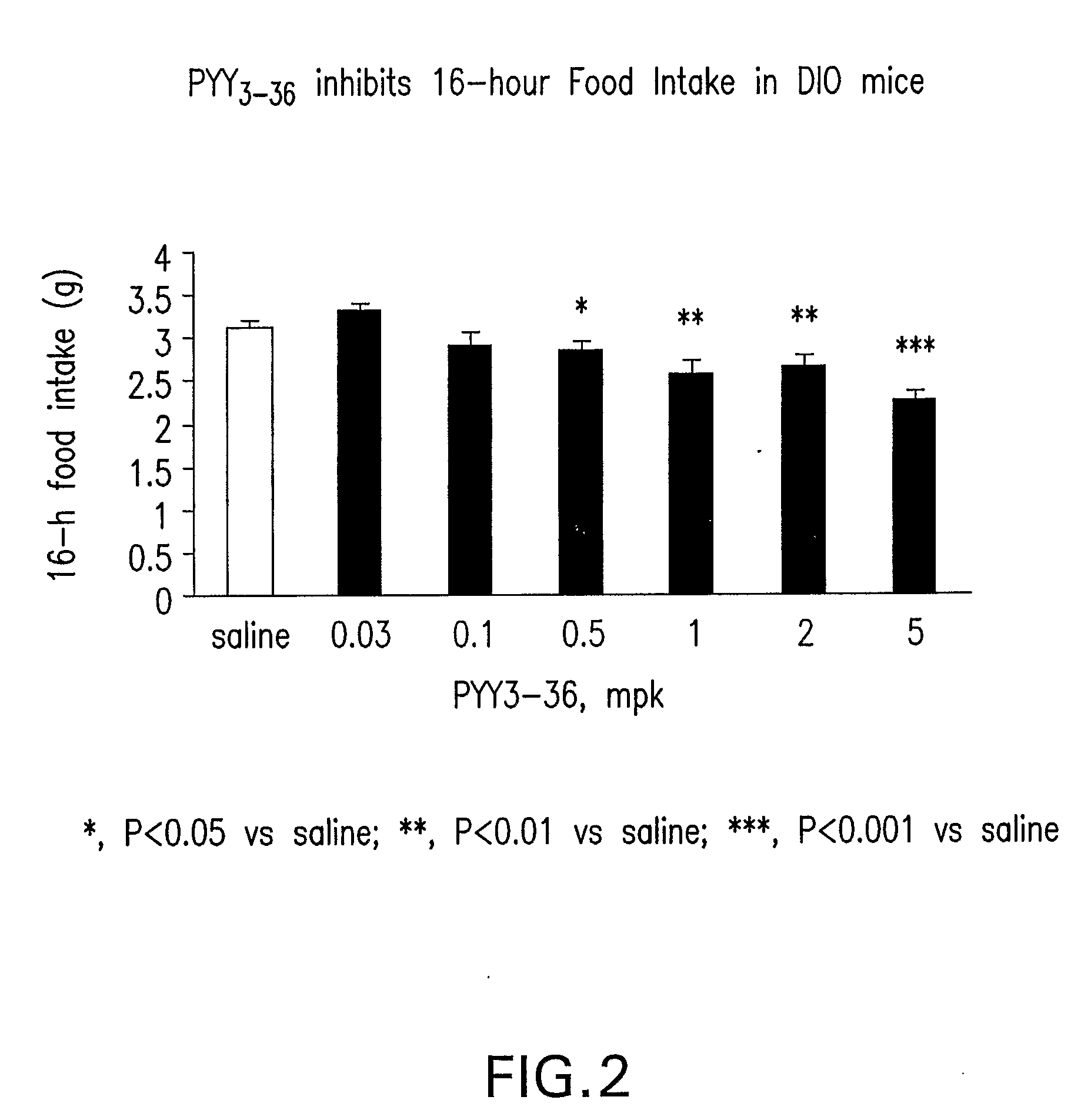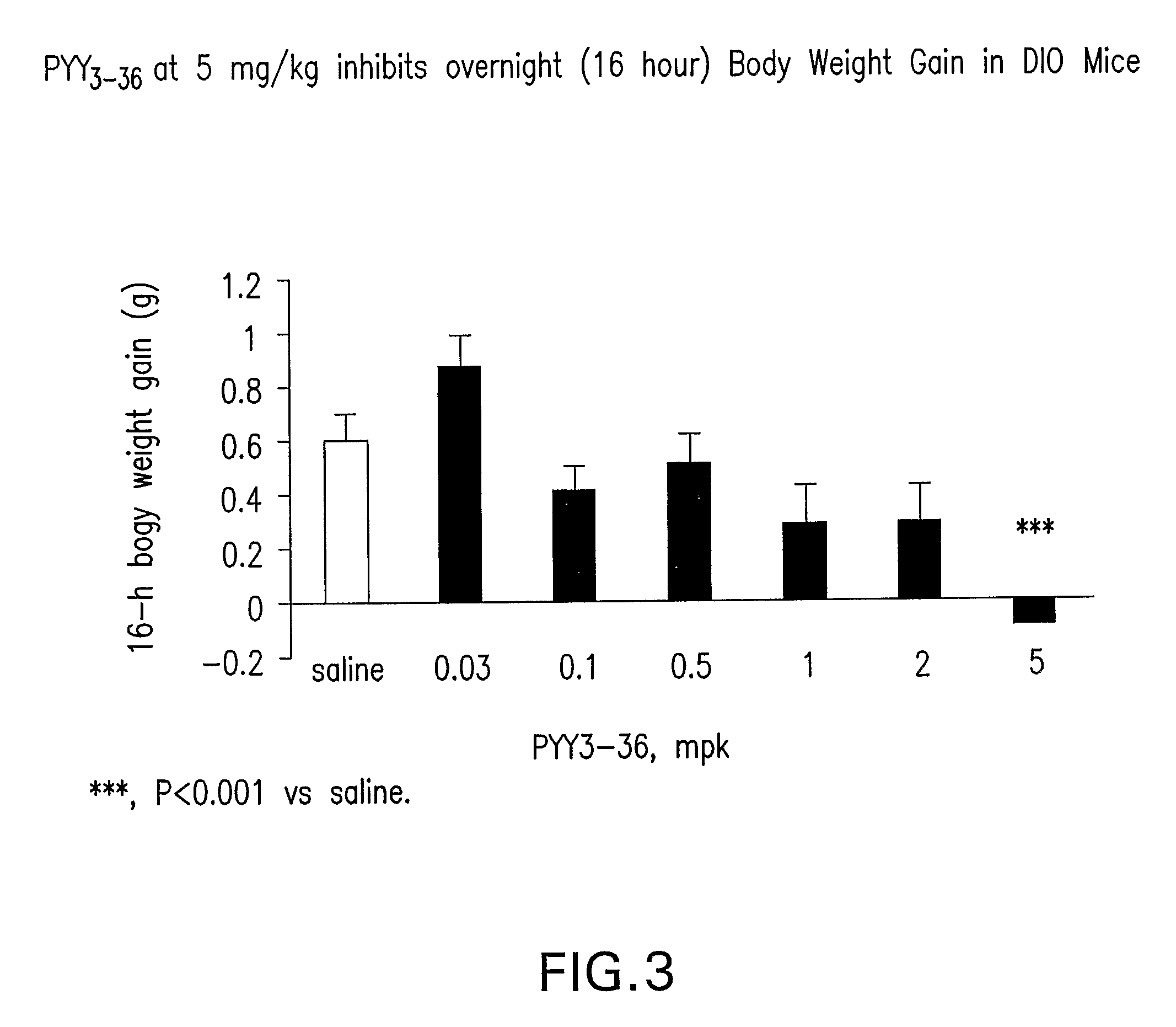Combination Therapy for the Treatment of Obesity
a combination therapy and obesity technology, applied in the field of obesity combined therapy, can solve the problems of obesity causing or exacerbated many health problems, significant increase in mortality and morbidity, and limited efficacy of weight loss drugs currently used in monotherapy for obesity treatment, and significant side effects
- Summary
- Abstract
- Description
- Claims
- Application Information
AI Technical Summary
Benefits of technology
Problems solved by technology
Method used
Image
Examples
example 1
In vivo Study of the Effect of PYY3-36 on 4 Hour and 16 Hour Food Intake and Body Weight Gain in DIO Mice
Materials and Methods
[0509] PYY3-36 was obtained from PeptidoGenic Research & Co., Inc. (Livermore, Calif.), CB1 antagonist AM251 was obtained from Tocris Cookson (Ellisville, Mo.).
[0510] Mice were individually housed in micro-isolator cages (Labproducts™). The animal room was set on a 12-hour light, 12-hour dark cycle (lights on at 7:00 am), with temperature and relative humidity maintained at 23+2° C. and 55±15%, respectively. Male C57BL6 mice (Taconic Farm) were fed on a MHF diet (Research diet 12451, 45% kcal from fat) at 8 weeks of age to develop diet-induced-obesity (DIO). The DIO mice used in the experiment were of 13 months of age, and were maintained on the MHF diet for 11 months. The average body weight of the mice was 55-56 grams. DIO mice feeding ad libitum were administered intraperitonelly (IP) with saline (n=12) and human PYY3-36 (0.03, 0.1, 0.5, 1.0, 2.0, 5.0 ...
example 2
In vivo Study of the Effect of the Combination of PYY3-36 and CB-1 Inverse Agonist AM-251, on Food Intake and Bodyweight
Materials and Methods
[0513] PYY3-36 was obtained from PeptidoGenic Research & Co., Inc. (Livermore, Calif.), CB1 antagonist AM251 was obtained from Tocris Cookson (Ellisville, Mo.).
[0514] Male C57BL6 mice (Taconic Farm) were fed on a MHF diet (Research diet 12451, 45% kcal from fat) at 8 weeks of age to develop diet-induced-obesity (DIO). The DIO mice used in the experiment were of 10 months of age, and were maintained on the MHF diet for 8 months. The average body weight of the mice was 57-58 grams. DIO mice feeding ad libitum on the MHF diet were conditioned by oral gavage (PO) with vehicle (5% Tween80 and 0.5% methylcellulose) and IP injection with saline. The mice were randomized and divided into 4 groups, which were administered with: vehicle; PYY3-36 (1 mg / kg, IP); AM251 (1 mg / kg, PO); and PYY3-36 (1 mg / kg, IP)+AM251 (1 mg / kg, PO). Sample sizes were n=12 ...
example 3
In vivo Study of the Effect of the Combination of PYY3-36 and Melanocortin 4 Receptor Agonist, Compound A, on Food Intake
Materials and Methods
[0517] PYY3-36 was obtained from PeptidoGenic Research & Co., Inc. (Livermore, Calif.), Compound A was synthesized at Merck Research Laboratories.
[0518] Male C57BL6 mice (Taconic Farm) were fed on a MHF diet (Research diet 12451, 45% kcal from fat) at 8 weeks of age to develop diet-induced-obesity (DIO). The DIO mice used in the experiment were of 10 months of age, and were maintained on the MHF diet for 8 months. The average body weight of the mice was 57-58 grams. DIO mice feeding ad libitum were conditioned by oral gavage (PO) with vehicle (5% Tween80 and 0.5% methylcellulose) and intraperitonel (IP) injection with saline. The mice were randomized and divided into 4 groups, which were administered with: vehicle; PYY3-36 (1 mg / kg, IP); Compound A (20 mg / kg, PO); and PYY3-36 (1 mg / kg, IP)+Compound A (20 mg / kg, PO). Sample sizes were n=12 ...
PUM
| Property | Measurement | Unit |
|---|---|---|
| mass | aaaaa | aaaaa |
| size | aaaaa | aaaaa |
| size | aaaaa | aaaaa |
Abstract
Description
Claims
Application Information
 Login to View More
Login to View More - R&D
- Intellectual Property
- Life Sciences
- Materials
- Tech Scout
- Unparalleled Data Quality
- Higher Quality Content
- 60% Fewer Hallucinations
Browse by: Latest US Patents, China's latest patents, Technical Efficacy Thesaurus, Application Domain, Technology Topic, Popular Technical Reports.
© 2025 PatSnap. All rights reserved.Legal|Privacy policy|Modern Slavery Act Transparency Statement|Sitemap|About US| Contact US: help@patsnap.com



